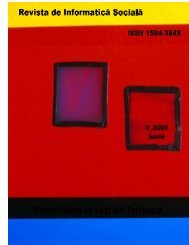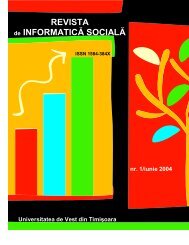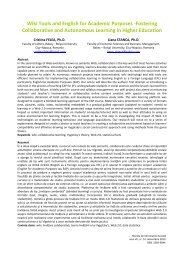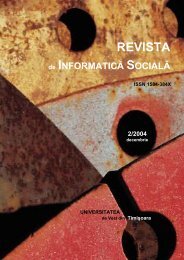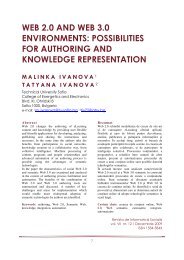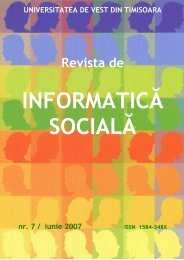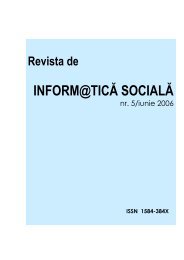No 13 - Journal of Social Informatics / Revista de Informatica Sociala
No 13 - Journal of Social Informatics / Revista de Informatica Sociala
No 13 - Journal of Social Informatics / Revista de Informatica Sociala
Create successful ePaper yourself
Turn your PDF publications into a flip-book with our unique Google optimized e-Paper software.
Such conditions may at least approximately be fulfilled among<br />
family members who share a microculture <strong>of</strong> mutual un<strong>de</strong>rstanding;<br />
people watching a specific event or TV broadcast (e. g. a football game or a discussion<br />
between presi<strong>de</strong>ntial candidates);<br />
employees working on a common project, with i<strong>de</strong>ntical procedures, technologies and goals;<br />
members <strong>of</strong> a "community <strong>of</strong> practice" who share i<strong>de</strong>ntical problem, concepts, methods and<br />
goals;<br />
individuals homogenenously socialized within a specific culture or institution.<br />
In all such cases, un<strong>de</strong>rstanding can be based on very few words, as there is no need to<br />
elaborate the <strong>de</strong>finitions <strong>of</strong> terms, to explain reasons why certain opinions are held or certain<br />
hypothesis are asserted – because all participants can rely on the premise that such interpretations<br />
are consensually shared. This may explain why Twitter usage is particularly high in Japan, Italy and<br />
Portugal: three countries in which most <strong>of</strong> the populations share a rather homogeneous intranational<br />
culture Osborne 2008).<br />
In addition, it explains the extensive use <strong>of</strong> Twitter among stock exchange brokers and the<br />
Securities and Exchange Commission (SEC). (Trombly 2008) as well as its application in sports<br />
media: e. g. in the case <strong>of</strong> a Washington Post reporter crew who use Twitter to keep fans updated<br />
about all events associated with the "Redskins" (football team) (Mascott 2008).<br />
For similar reasons, Twitter has become almost indispensable for all sorts <strong>of</strong> rescue<br />
organizations (like the Red Cross; Doll 2008), because any catastrophic event creates a highly<br />
specific common environment that facilitates very short communications.<br />
On the other hand, Twitter is much less a<strong>de</strong>quate for highly explicit, elaborated<br />
conversation: e. g. in cases <strong>of</strong> intercultural exchanges, where there is a need to use an “elaborated<br />
co<strong>de</strong>” 5 clarify terms or to add metacommunicative specifications. For the same reasons, it is not<br />
useful for any kind <strong>of</strong> narrational communication: for telling stories or for purposes <strong>of</strong> <strong>de</strong>briefing.<br />
This also implies that when a new participant enters online communication (or when an<br />
existing actor initiates a new topic), there is an initial phase when traditional Websites or Blogs are<br />
more a<strong>de</strong>quate than Twitter because new i<strong>de</strong>as have to be expressed that need rather elaborated<br />
verbal explications (Wallace 2008).<br />
For the same reasons, Twitter is a most "ahistorical medium". While tweets can be<br />
technically stored for in<strong>de</strong>finite time like Email or Blog entries, there is <strong>of</strong>ten not much reason to do<br />
so, because when they are read months or years afterwards, their meaning is hard to assess as the<br />
situational context <strong>of</strong> their origin can no longer be reconstructed.<br />
9. CONCLUSIONS<br />
By continuing the unforeseen success story <strong>of</strong> short telephone messages (SMS), Twitter<br />
illustrates that rule that media with very low bandwidth can assume highest significance in social<br />
life, because given their low cost and ubiquitous presence, they can more easily and more<br />
extensively be integrated into social interaction processes and role systems than more sophisticated<br />
(e.g. multimedia) technologies.<br />
By lowering the threshold for sending and receiving messages, Twitter contributes to the<br />
Real Time omnipresence <strong>of</strong> the Net even on the very lowest "molecular" levels <strong>of</strong> (hitherto private<br />
and covert) individual and social activities, reflections, emotions and communications - thus<br />
increasing additionally the reach <strong>of</strong> the public sphere which has already been enlarged so much by<br />
the conventional services like Email and the WWW.<br />
On the other hand: by its capacity to boost asymmetric lea<strong>de</strong>r-follower relationships, to<br />
facilitate spontaneous Real-Time utterances and to provi<strong>de</strong> push signals for directing attention, it is<br />
highly complementary to most other Internet applications that emphasize more symmetric<br />
5 Dito.<br />
pag. 16: <strong>Revista</strong> <strong>de</strong> Informatică <strong>Social</strong>ă | Vol. III (<strong>13</strong>) / 2010 | ISSN 1584-384X



